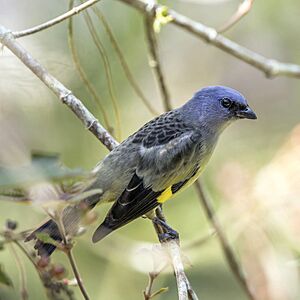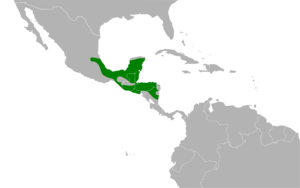Yellow-winged tanager facts for kids
Quick facts for kids Yellow-winged tanager |
|
|---|---|
 |
|
 |
|
| In Belize | |
| Conservation status | |
| Scientific classification | |
| Genus: |
Thraupis
|
| Species: |
abbas
|
 |
|
The yellow-winged tanager (scientific name: Thraupis abbas) is a colorful bird from the tanager family. You can find it in warm, tropical parts of the Americas. This bird is about 18 centimeters (7 inches) long, which is an average size for a tanager. It stands out because of the bright yellow patches on its dark green wings. Its body is mostly a mix of dark blue and gray. Young yellow-winged tanagers look a bit different. They have an olive-green head and upper back, and they don't have the pale lavender color on their throat and chest yet.
Contents
Where Yellow-winged Tanagers Live
The yellow-winged tanager lives in open forests that are humid and moist. These birds love areas with lots of trees and plants. They often hang out in large groups. Sometimes, you can see flocks of 50 or more of these birds flying together!
What Yellow-winged Tanagers Eat
These tanagers enjoy a varied diet. They eat different kinds of fruits they find in the trees. They also catch insects for protein. Sometimes, they sip nectar from flowers, just like hummingbirds do.
Sounds of the Yellow-winged Tanager
The yellow-winged tanager has a special call. It is a high-pitched, whistling sound. You might hear them making this sound while they are flying. They also call out when they are sitting on a branch.
Nests and Eggs: Reproduction
The yellow-winged tanager builds a small, cup-shaped nest. They make their nests from dried plant fibers and leaves. They also use soft mosses to line the inside. These nests are usually placed in the middle part of trees.
Yellow-winged Tanager Eggs
The female tanager usually lays three eggs. These eggs are gray in color. They also have brown spots or patterns on them.
Where to Find Yellow-winged Tanagers
You can find the yellow-winged tanager along the coasts of the Gulf of Mexico and the Caribbean Sea. Their home range starts in parts of Mexico, like Veracruz and southern San Luis Potosi. It stretches all the way through the Yucatán Peninsula down to Nicaragua.
Pacific Coast Sightings
On the Pacific coast, these birds live from the Mexican state of Chiapas down to Honduras. They are generally quite common in all these areas. Since 2010, they have also been seen in Los Chiles, which is in northern Costa Rica.


